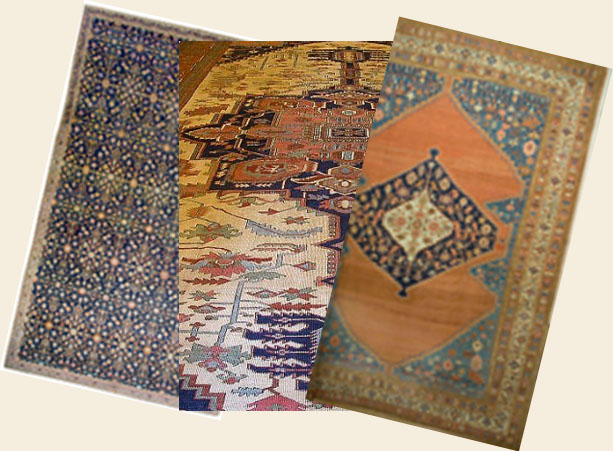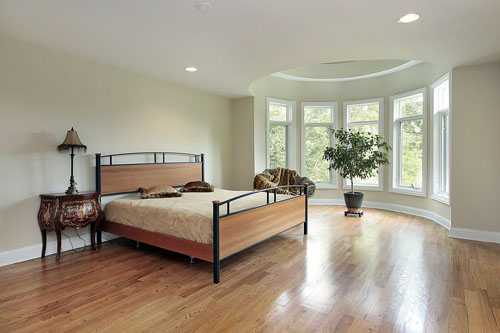Spotlight on Special Rugs – 1

Spotlight on Special Rugs Heriz Rugs Three Unusual Heriz Area Rugs The usual Heriz rugs are in a 9’ x 12’ size medallion and corners semi-geometric, rustic creation. These three are, to varying degrees, none of the above. Rug CU-278 9’4 x 12’5 Consider first this Heriz rug. The border is minimal, the better to allow the repeating allover textile pattern to escape under it and extend to the very edges of the universe. The millefleurs- like pattern, executed in light colors, is cleverly delineated by thin, curving light lines to inscribe a cartouche pattern. But nothing is forced on
Aaaaaargh! My Rug Has Vanished !!!!!!!!!!!

Aaaaaargh! My Rug Has Vanished How Did This Happen !!!!!!!!!!! First it was the color in the rug. Then the design in the rug went. Finally, the format disappeared. Now all I have is a bare floor no carpet! How did this happen AND what can be done about it? A Bit Of Rug History Before getting so hyperventilated, a bit of history is in order. By rug we mean the oriental room size or scatter rug. Going back to the 14th century, we find large Anatolian carpets on floors in Italian frescoes and easel paintings. Through the Renaissance this was
Tapestry Producing Areas and Styles

Tapestry Producing Areas & Styles Antique Tapestry – Most Antique Tapestries that are available nowadays are from France, Holland (known as Flemish), Belgium and England. Some of the more famous areas are Aubusson Situated on the banks of the River Creuse in France, has been well known for producing tapestries from around 1560. Audenarde/ Oudenaard A Belgian municipality in the Flemish province of East Flanders. Weaving tapestries from the 15th century Beauvais Is a town in northern France that started manufacturing tapestries from around 1600. Bruges Based in the Flemish region of Belgium. It is located in the northwest of the country. Weaving tapestries
Navajo Rug Record Tumbles
The world record price for a North American textile was smashed to smithereens at John Moran Auctioneers in Pasadena, California on 19 June 2012 when a Classic Navajo First-Phase Chief-style wearing blanket was bought for $1.8 million. The Chantland Blanket, woven in the mid-19th century from handspun wool in natural ivory, dark brown and black, as well as indigo-dyed blue and lac-dyed red, is in good condition, of exceptional rarity (and beauty), and has exemplary provenance. It was consigned to Moran’s by a descendant of a Johan Tjentland, later known as John Chantland, a Norwegian settler who owned a dry
Silk Weavings from Isfahan
Isfahan was the Central and Cultural capital of the Persian Empire of Shah Abbas throughout the 16th and 17th Century. Isfahan is already a city of ancient history and considerable wealth when Shah Abbas decides, in 1598, to turn it into a magnificent capital. It has a Masjid-i-Jami, or Friday Mosque, dating from the Seljuk period (11th-12th century), still surviving today and noted for its fine patterned brickwork. And it has a thriving school of craftsmen skilled in the making of polychrome ceramic tiles. Shah Abbas favor’s in architecture what comes to seem almost the theme of his city –
The 8 Points to a Carpet Part 2 5-8
Point 5: shearing in all pile carpets, after coming off the loom, the pile requires a shearing or cutting of the pile. most of the countries are still using a hand shearing process, where people use large cutting shears, cutting the pile. the important element to keep an eye out for is how even the shearing process is. if the pile is cut to0 low at certain points, then, a result can be unusual shading. normally the pile is cut in one direction. the natural phenomenon of a light and dark version of the carpet from one end to
The 8 Points to a Carpet Part 1 1-4
Point 1: foundation the foundation of a carpet would refer to the knot count. most oriental carpets’ knots are counted based upon a knot per square inch count. one would simply count the number of knots from an inch measured from the width, multiplied to the knot count measured one inch along the length. a per square inch count would result. one can also examine the various knot tying techniques, ranging from the persiansennehknots, to the turkishghiordes knots, to the double tibetan knots. there is also another category of carpets that are flat, with no pile. these are kilims (a
What’s happening with rugs?
By Lida Lavender It is my feeling that the wave of the future may just rest in the past. As a part of the rug trade for the last 22 years, I can’t help but fall in love with a new rug every single day. Rugs, tapestries and textiles of the late 19th century are some of the most beautiful / decorative art forms in the world, and there are days when I can’t help but feel like a kid in candy store. As the years go by, I tend to gravitate more towards the early rugs of the 16th
Tips for Buying an Oriental Carpet – Part 3: How to Choose an Oriental Rug
Now that you have some basic knowledge under your belt, let’s start putting the pieces together. Before you begin your search, take some time to decide what size and color you are looking for. Ideally, as conventional wisdom says, decorating a room should start with the Oriental rug because of the multitude of paint and fabric choices as opposed to the finite color and style of a chosen antique oriental rug. Now, that’s great if you’re starting from square one, but like most people, you are likely choosing a rug for an existing space that has a defined color and
Tips for Buying an Oriental Rug – Part 2: Hand-Made Oriental Rugs vs. Machine-Made Oriental Rugs
This is the second part in our series designed to educate you in the major aspects of buying antique oriental rugs and vintage oriental rugs. In this part, we will discuss how oriental rugs are made in order to illuminate the artistry behind these cherished works of art. Chances are, if you’ve been looking through antique oriental rugs already, you will have noticed that there are two broad categories of rugs: hand made oriental rugs and machine made oriental rugs. Since oriental rugs were originally woven by hand, let’s start with those beauties. Hand-Made Oriental Rugs These are made on







